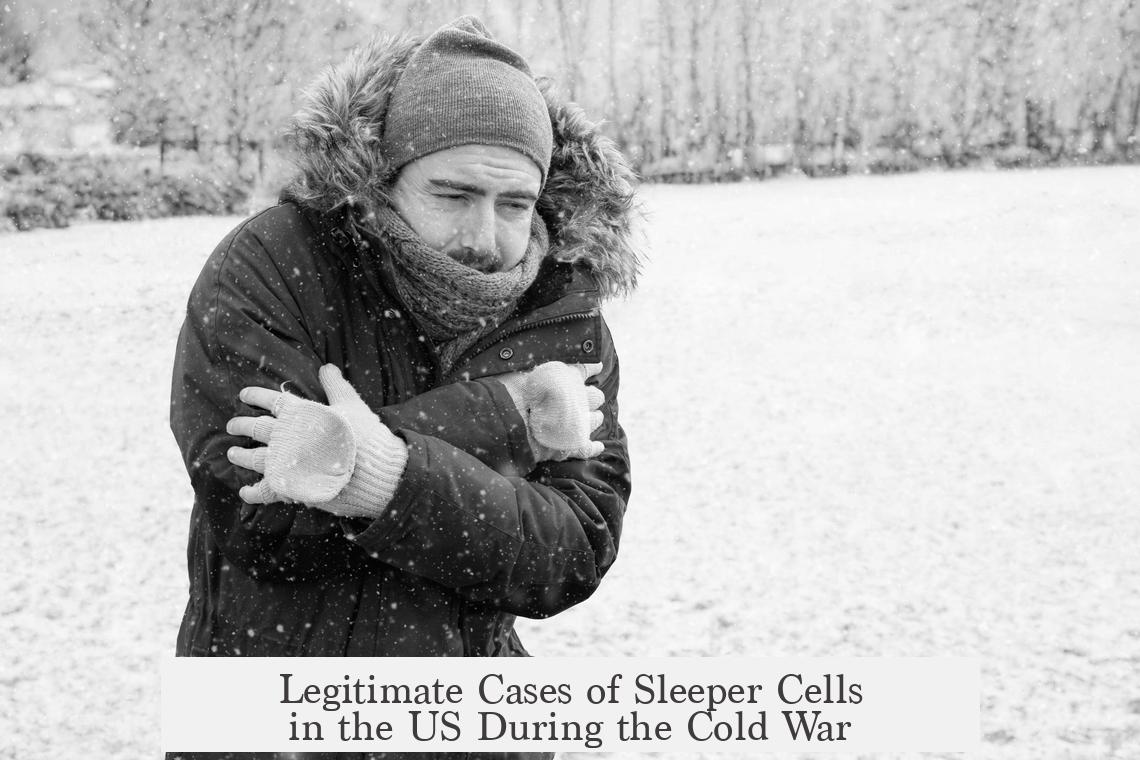There were no widely confirmed cases of violent or active sleeper cells operating within the United States during the Cold War, as commonly portrayed in popular media. Instead, Soviet agents in the US primarily functioned as couriers and spies focused on gathering and transmitting intelligence, rather than engaging in sabotage or assassinations.

During the Cold War, the Soviet Union used illegal agents, often called “illegals,” to maintain espionage networks in the US. These agents lived covertly, sometimes under false identities, and served mainly to ferry information between Soviet handlers and spies embedded in American institutions. Unlike the dramatic sleeper agents seen in television shows, these operatives led relatively mundane lives and avoided attention.
One of the most notable Soviet illegal agents was Rudolph Abel, who entered the US in 1948 to revive Soviet espionage after World War II. He activated networks that included individuals such as Julius and Ethel Rosenberg, who famously conspired to pass atomic secrets to the USSR. While the Rosenbergs were executed following their conviction, their case remains the most prominent example of Soviet spying involving long-term agents living as ordinary Americans.

Abel’s assistant, Reino Hayhanen, inadvertently exposed a spy method in 1953 when a hollow nickel containing microfilm was broken open by a paperboy. This discovery alerted the FBI to active Soviet espionage efforts in the US, although decrypting the captured material proved difficult at the time. Such incidents underline how Soviet spies operated through discrete communications rather than dramatic actions.
Most Soviet illegal operatives functioned as conduits rather than direct agents gathering intelligence themselves. Their job was to receive data from spies embedded in US government agencies and deliver it to KGB representatives, often stationed legally within Soviet embassies. This courier role was critical to Soviet intelligence strategies but did not involve the covert sabotage or assassin activities often attributed to sleeper cells in fiction.

Claims surfaced from defectors like Vasili Mitrokhin and analysts such as Christopher Andrew, alleging that the Soviet Union planned extensive sabotage campaigns in case of war with the US. Preparing weapons caches and safehouses in multiple countries, including the United States, suggested potential infrastructure for disruptive activities. However, there is no verified evidence that Soviet sleeper agents in the US engaged directly in this sabotage. Any such actions would likely have been conducted by specialized Soviet forces, such as Spetsnaz operatives, rather than civilian sleeper agents.
After the execution of the Rosenbergs and exposure of other atomic spies, the American Red Scare and McCarthyism created a hostile environment that curtailed Soviet espionage activities within the US. This crackdown hindered the KGB’s ability to rebuild extensive clandestine networks. Despite this, some espionage successes persisted. For example, John Anthony Walker operated a spy ring from the late 1960s to the 1980s, providing the Soviets with critical naval intelligence. Walker’s case, however, was more espionage than a sleeper cell function.

| Aspect | Cold War Reality |
|---|---|
| Role of Soviet Agents | Primarily couriers and intelligence gatherers |
| Famous Cases | Rosenbergs (atomic espionage), John Anthony Walker (naval intelligence) |
| Violent or Sabotage Activities | Not confirmed; planned but not executed by sleeper agents in US |
| Operational Style | Living ordinary lives, low-profile courier work |
| Impact of US Counterintelligence | Significant; hampered Soviet efforts post-1950s |
In essence, while Soviet espionage during the Cold War in the US was active and at times effective, the concept of “sleeper cells” engaging in violent or dramatic covert operations within American society lacks substantiated evidence. The typical Soviet illegal agent functioned as a quiet courier between spies and handlers. Espionage focused on intelligence gathering, especially atomic secrets and military information.
- Soviet “illegals” in the US mainly served as communication links, not active saboteurs.
- The Rosenbergs are the most famous Soviet spy case, tied to atomic secrets.
- Planned sabotage infrastructure existed, but direct US sleeper cell attacks are unproven.
- US counterintelligence and political scrutiny reduced Soviet espionage activities.
- Espionage successes like John Anthony Walker highlight ongoing spying, not sleeper cell action.
Were There Any Legitimate Cases of “Sleeper Cells” in the US During the Cold War?

The answer is yes—but with a twist: most “sleeper cells” weren’t shadowy murder squads lying in wait. Instead, many were well-hidden but ordinary people, mainly couriers, quietly passing information, not staging dramatic acts of sabotage or assassination. Let’s unpack this Cold War espionage tale.
Picture the Cold War spy scene: It isn’t all cloak-and-dagger fights and shootouts like in the TV show The Americans. The reality is subtler and, frankly, less Hollywood-worthy. Soviets did have agents living undercover in America, but their roles looked very different from what fictional tales would have us believe.

First, understand that the Soviet Union employed illegal agents—spies without diplomatic immunity. Their job was less “action hero” and more “secret messenger.” These agents worked as couriers, bridging the gap between official KGB officers in embassies and spies already embedded inside the government or military. The agents themselves rarely sparked chaos or violence but ensured secrets traveled back home.
Take Rudolph Abel, for instance. He arrived stateside in 1948 with a mission: revive the network of nuclear spies leaking atomic secrets during World War II. Abel’s team included the infamous Rosenbergs, Julius and Ethel, who supplied the Soviets with sensitive information on U.S. nuclear research at Los Alamos. This isn’t spy cinema soap opera; these were serious players fueling the Soviet nuclear effort.

Yet, Abel and his crew lived quiet lives. Their espionage involved dead drops, coded messages, and courier duties rather than car chases or midnight assassinations. The “sleeper” aspect was more about blending in, not about violent sleeper hits.
Interestingly, the FBI’s breakthrough in exposing some of these spies came from a paperboy accidentally spending a hollowed-out coin filled with microfilm—an accidental leak in the crisp Soviet network, not a dramatic shootout or interrogation. Reino Hayhanen, Abel’s assistant, lost this tiny piece of spy tech which led the FBI to the discovery, though cracking the code remained tough.
Now, what about sabotage? Defector Vasili Mitrokhin revealed in The Sword and the Shield that the Soviets planned a broad sabotage campaign in case of war. He claimed caches of weapons and safehouses were ready for attacks on vital U.S. infrastructure like oil refineries and power plants. While evidence supports the existence of such caches throughout Europe, Canada, and even the U.S., these operations likely relied on elite Soviet forces like the Spetsnaz, not sleeper cells acting independently inside America.
Such claims might inspire thrilling TV drama, but in reality, any sleeper agents would function as organizers, not direct saboteurs. The day-to-day tasks still involved waiting and passing information quietly rather than launching explosive missions.
What about famous cases beyond the Rosenbergs? The Rosenbergs stand out as a rare but true deep infiltration case leading to significant damage to U.S. security and their eventual execution. But they were exceptions rather than the rule. The Cold War saw many other atomic spies, yet these were individuals embedded in government or military roles rather than full-fledged sleeper cells.
As for widespread sabotage cells lurking unnoticed? The evidence doesn’t support elaborate networks ready to blow up America from within. Most Soviet espionage efforts focused on intelligence gathering through secret channels, not covert paramilitary operations on U.S. soil.
Did the Red Scare and McCarthyism stomp out all Soviet sleepers? Not quite. While Senator McCarthy’s campaigns likely disrupted many KGB efforts to rebuild networks after the atomic spies were exposed, Soviet espionage carried on. For example, John Anthony Walker, a U.S. Navy officer, spied for the Soviets for nearly two decades, revealing crucial naval secrets. He wasn’t a classic sleeper agent but a high-level insider aiding the Soviets from within.
So, how does this reshape our view of Cold War sleeper cells? Rather than violent sleeper assassins or saboteurs living double lives, legitimate cases mostly involved quiet couriers whose mission was info traffic, not destruction. The Soviet approach leaned on subtlety and secrets, not dramatic attacks.
If you’ve been captivated by spy thrillers, this might seem a bit anticlimactic. But understanding the realities highlights the sophisticated and patient nature of Cold War espionage. The spies weren’t always flashy villains; they were often unremarkable people living ordinary lives—waiting, passing notes, and influencing world events under the radar.
In conclusion, yes, legitimate sleeper agents existed during the Cold War in the U.S., but the idea of sleeper cells as violent actors is largely a myth of popular culture. The truth lies in quiet courier roles, secret networks, and a few high-profile atomic spies. As historian Vasili Mitrokhin’s revelations show, plans for sabotage were real but probably reserved for wartime actions by trained operatives, not dormant household spies.
So next time you binge espionage dramas, remember the spies behind the scenes. They’re less James Bond and more secret mail carriers with long memories and steady hands.




